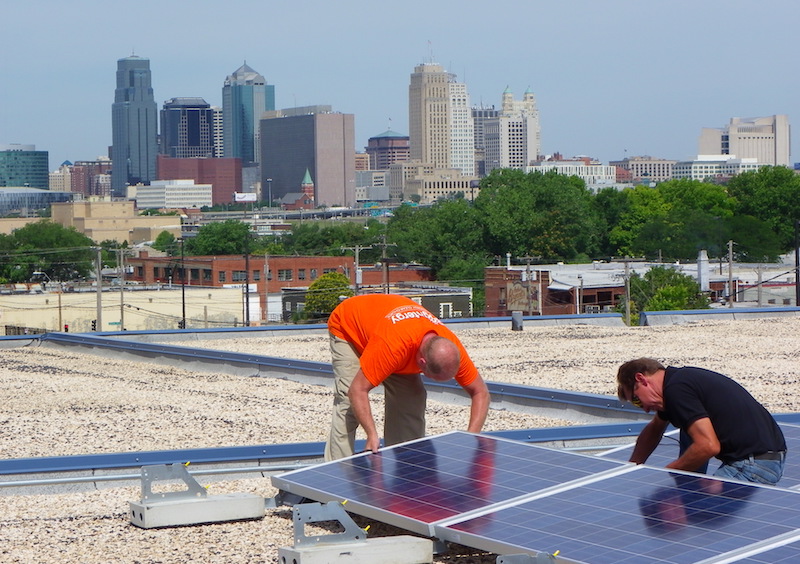The city of Kansas City, MO has reduced its greenhouse gas emissions by 40 percent below year 2000 levels, surpassing its goal of a 30-percent reduction by 2020, according to a new KCMO Greenhouse Gas (GHG) Inventory Update.
“The achievement of surpassing the city’s goal of reducing GHG emissions from municipal operations is a major milestone in our climate work, reflecting a substantial commitment by the city’s elected officials, Climate Protection Steering Committee, city staff and many community partners who have worked with us over the past decade,” said Dennis Murphey, KCMO chief environmental officer. “It sets the bar even higher for future GHG reductions.”
The KCMO report comes on the heels of the United Nations scientific panel report on climate change that calls for immediate and dramatic reductions in greenhouse gas emissions to slow climate change. The report released Monday by the Intergovernmental Panel for Climate Change found that if greenhouse gas emissions continue at the current rate, the atmosphere will warm by as much as 2.7 degrees Fahrenheit above preindustrial levels by 2040, resulting in devastating floods, drought, wildfires, food shortages and poverty. The report shows the increase in temperature is expected to occur much quicker than earlier reports predicted.
Kansas City officials and business leaders stepped up their efforts to reduce greenhouse gas emissions after the city council adopted a Climate Protection Plan in 2008. The goal then was to reduce city government GHG emissions by 30 percent below 2000 levels by 2020 and reduce citywide GHG emissions to 30 percent below 2000 levels by 2020 and 80 percent by 2050.
Since 2000, total citywide emissions have decreased despite a growing population, resulting in an overall decrease in emissions of 21 percent below the 2000 baseline. The reductions are primarily attributed to reductions in building energy use with progress in the transportation sector.
“The progress in citywide GHG emission reductions positions the city to meet our pledge to do our share to meet the U.S. commitments in the Paris Climate Agreement, despite the federal government’s intent to withdraw from that international climate accord,” Murphey said. “In view of the new Intergovernmental Panel on Climate Change report, our work is more important than ever.”
The KCMO report shows results of the 2017 GHG emissions inventory and progress in the last four years toward the city’s GHG goals. The emissions generated citywide in Kansas City in 2000 totaled 10.9-million metric tons of carbon dioxide equivalent (MTCO2e). To meet the 2020 citywide goal, the city will need to maintain the same reduction trend that was seen from 2013 to 2017 and reduce emissions at least 948,000 MTCO2e.
The city has taken the lead in greenhouse gas reduction by conducting a separate GHG inventory of all municipal operations. In 2000, municipal operations generated 384,000 MTCO2e, or approximately 3 percent of citywide emissions. Municipal emissions have decreased each year and in 2017 were 230,000 MTCO2e, a decrease of 40 percent below the 2000 baseline.
Energy use in buildings has been the primary source of emissions in Kansas City, contributing about 60 percent of the total emissions generated by the community. The 2017 report shows this is a decrease over previous inventories. As building energy emissions have decreased, on-road transportation’s share has increased to 34 percent, now making up more than a third of the city’s total emissions. If the city’s current emissions trends continue, transportation emissions will outweigh all building emissions before 2025, according to the report.
The report shows that the reduction in electricity emissions can be attributed to a 5-percent reduction in consumption and a 23-percent reduction in KCP&L’s emissions since 2000 from increased use of renewables and natural gas in its fuel source mix.
Kansas City has been working to reduce energy use and GHG emissions for more than 18 years. Some of those efforts include:
- In 2013, Mayor Sly James issued an Energy Challenge for building owners to voluntarily benchmark energy use by 2014. As a result, 175 building owners committed to benchmarking, representing 25-million square feet of floor space.
- In 2014, the mayor issued an Energy Challenge for building owners to improve their ENERGY STAR scores. As a result, 38 buildings showed improved energy efficiency from 2014 to 2016 (including 25 school buildings), representing more than 5-million square feet of floor space.
- In 2015, the city adopted an ordinance establishing the Energy Empowerment Program, which requires owners of private and public buildings to benchmark their energy use with the Environmental Protection Agency’s (EPA) Portfolio Manager and report that energy use to the city annually.
- Since 2013, the city has installed 1.5 megawatts (MW) of solar-energy generating capacity on the rooftops of 60 municipal buildings.
- The city converted 380 streetlights to LEDs since 2013.
- Beginning in 2016, Kansas City Power & Light Company (KCP&L) conducted a two-year Strategic Energy Management program to support energy-efficiency improvements by 20 of its largest commercial and industrial customers, including city facilities.
- The city launched a new streetcar in the loop from the River Market area to Union Station in 2015.
- Property Assessed Clean Energy (PACE) loans have been used to implement $15 million in energy-efficiency improvements to nine commercial buildings and $8.16 million in the residential sector to complete 847 energy-efficiency and solar projects since September 2016.
- Kansas City was one of 10 cities nationwide selected to participate in the City Energy Project, a three-year initiative to promote energy efficiency in large commercial and institutional buildings from 2014 to 2016.
- An Energy Data Accelerator was a two-year initiative partnership with KCP&L to help aggregate energy use data in multi-metered buildings to prepare for energy use benchmarking.
- Bike KC is a plan to develop a transportation network, including 600 miles of on-street bicycle facilities.





This is so awesome! I wish St. Louis would quickly follow suit, but probably never with Ameren being our utility provider.
Keep in mind though that this is only municipal operations and not the entire metro area population. Unfortunately Missouri limits what you can compel people to do if it is any financial burden (Hancock Amendment).
Municipal operations only contributes a small part to Kansas City area greenhouse gas emissions.
There is a lot more work to be done. Ideally a carbon tax would help.
Great work!! I love it when I see people taking action to help our environment.